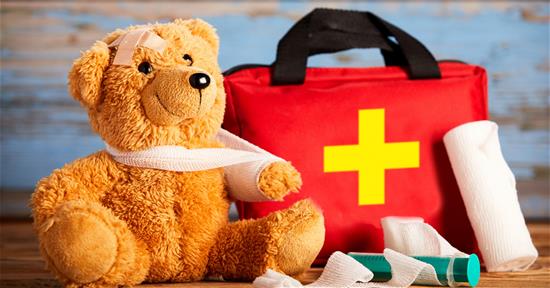- 844.422.9533
- Schedule a Tour
Accidents happen, but you can be prepared.
 As parents, we wish we could prevent every injury, but it’s inevitable that kids will get hurt sometimes. It’s just part of growing up, being adventurous, and testing the boundaries of what they can (and can’t) do.
As parents, we wish we could prevent every injury, but it’s inevitable that kids will get hurt sometimes. It’s just part of growing up, being adventurous, and testing the boundaries of what they can (and can’t) do.
We’ve compiled a quick reference list of first aid kit essentials, so you always have what you need to handle the basics at home or on the go. We’ve also put together a list of some helpful tips for treating common injuries. That way, you’ll know exactly what to do the next time your child has a big oops that needs more than just a comforting snuggle.
FIRST AID KIT ESSENTIALS
Restock your kit at least once a year. Bandages go quickly and medicine can expire. The American Red Cross suggests the following items for a family of four:
- 2 absorbent compress dressings (5 x 9 inches)
- 25 adhesive bandages (assorted sizes)
- 1 roll of adhesive cloth tape (10 yards x 1 inch)
- 5 antibiotic ointment packets
- 5 antiseptic wipe packets
- 2 packets of aspirin (81mg each)
- 1 emergency blanket
- 1 breathing barrier (with one-way valve)
- 1 instant cold compress
- 2 pairs of non-latex gloves (size: large)
- 2 hydrocortisone ointment packets
- 1 3-inch gauze roll bandage
- 1 roller bandage (4 inches wide)
- 5 3 x 3-inch sterile gauze pads
- 5 sterile gauze pads (4 x 4 inches)
- 1 thermometer (non-mercury/non-glass)
- 2 triangular bandages
- 1 pair of tweezers
If someone in your family does experience an injury, please do not hesitate to call 911 if you are facing a more serious emergency, beyond the minor cuts, bumps, and bruises that follow in our quick reference list. You may also want to consider taking a First Aid training course.
SIMPLE CUTS
- Press gently on the wound with a piece of gauze or clean cloth to stop the bleeding.
- Rinse the wound with running water until all dirt or foreign materials are gone.
- Pat the area dry and dab on an antibiotic ointment, like Neosporin, then apply a bandage.
- Avoid cleaning cuts with alcohol or hydrogen peroxide. This can kill off healthy cells that could be working to heal the wound.
- Monitor the wound over the next several days for any signs of infection (inflammation, oozing, or complaints from your child that it remains painful).
MILD BURNS
- Hold the area under cool water for 10-15 minutes to ease the pain and inflammation. Repeat as necessary or substitute with an ice pack.
- Apply an antibiotic ointment or aloe vera to soothe the burn and help skin cells regenerate.
- If a blister forms, leave it be to help prevent infection. Once the blister pops on its own, apply an antibiotic ointment and a clean bandage.
- Avoid using Vitamin E or butter on the fresh burn, as both can be irritating.
- Never place ice directly on the burn. This can cause tissue damage.
INSECT STINGS
- Wrap an ice pack in a thin towel and apply it to the site of the sting to decrease swelling.
- Use calamine lotion or another anti-itch cream to help reduce irritation.
- Monitor your child for hives or welts. Head to the emergency room if any develop.
- Don’t squeeze the stinger. This can cause more venom to be released into the body. Instead, use the edge of a credit card or sturdy flat object to scrape the stinger out.
NOSEBLEEDS
- Have your child tilt their head forward slightly.
- Avoid letting your child tilt their head back. Blood could run down their throat and into their stomach, which could cause them to throw up.
- Hold a washcloth or tissue to their nose, pinch their nostrils shut to add pressure. This often helps to stop the flow of blood while they calmly breathe out of their mouth.
- Discourage your child from blowing their nose for several hours after the bleeding has stopped. Even a gentle blow could cause the bleeding to start again.
BUMPED HEAD
- Wrap an ice pack or a bag of frozen vegetables in a thin towel and hold it against the area to reduce swelling.
- Avoid giving ibuprofen to a child with a head injury. If the injury is severe, the drug could cause increased bleeding.
- Monitor for any signs of a serious head injury or concussion, including confusion, worsening headache, slurred speech, etc.
As always, in any situation, consult a doctor if your child’s injuries are severe or if you have lingering concerns about their behavior after an injury.
Additional online resources:
